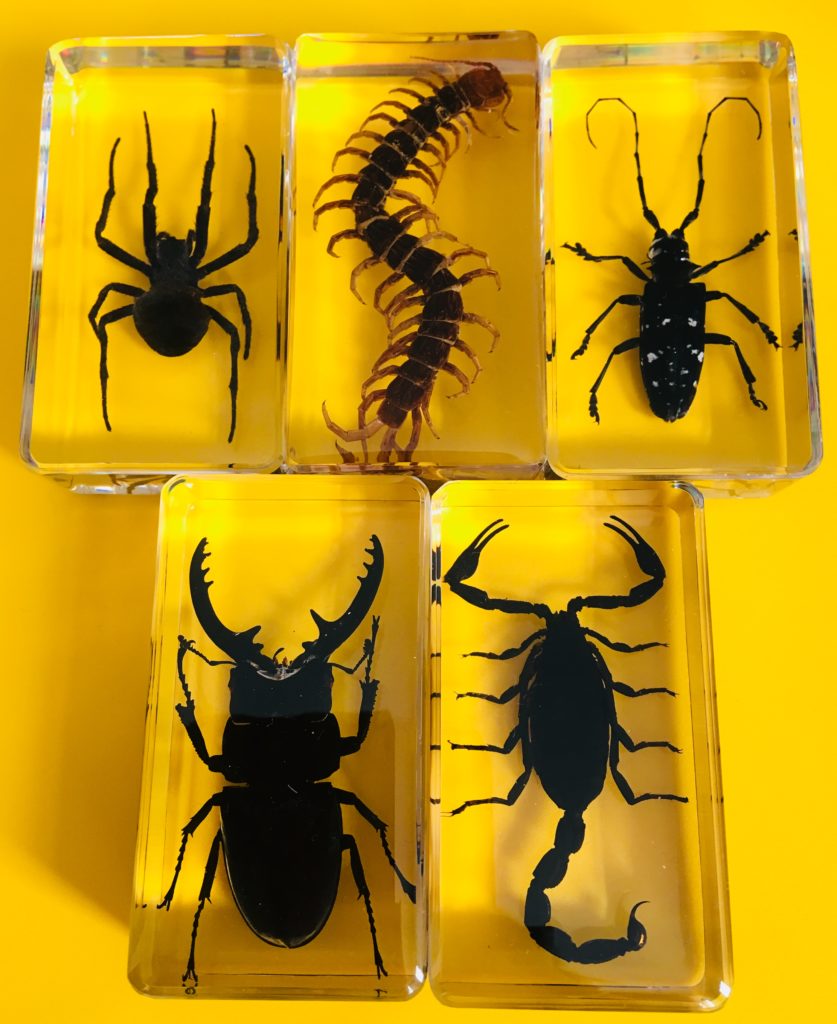Who glows there?
Invertebrates have adapted to the habitats they live in, in many weird and wonderful ways. But sometimes they leave scientists puzzled. Use a tray to examine bugs under ultra-violet light and find out why.


You will need (per group of 4):
- 1x black Gratnells Deep or Jumbo tray
- A selection of invertebrates in resin including one or two scorpions
- 1x UV torch
- 1x A3 sheet of black sugar paper or card
- Sticky tape
- Paper and pen
This activity also works for individuals or smaller teams, just increase the amount of time allocated to complete it. Once prepared, this activity can be repeated multiple times, reusing the same equipment for each team.
Preparation:
- Use the sticky tape to attach the black paper or card across the top of the tray. It should cover around 3/4 of the opening.
What to do:
- Shine your UV torch onto the table – what colour is the beam?
- Look at your selection of invertebrates in resin. Find the one with the fewest legs and place it inside the tray, underneath the black card.
- Shine the torch directly at the invertebrate you have chosen. What do you notice? Record what you see.
- Repeat with all of the invertebrates you have, from fewest legs to most.
- Which creature glowed under the UV light? Why do you think they do this?
What is happening?
Scorpions fluoresce green under ultra-violet light. Scientists have been investigating why they might have evolved to do this and have several theories. These have included helping them to lure or distract prey or to help them see at night. The latter is thought possible because UV light from the sun is reflected by the moon. Scorpions are nocturnal and very sensitive to light. By glowing, this could help them to know if they are exposed to predators in the dark and warns them to find shelter.
Another theory is that when scorpions evolved, levels of UV were high, so scorpions needed protection. The material in the exoskeleton that makes them glow acts like a sunscreen, protecting them from the rays.
The research continues so it remains a mystery. Glowing can actually be a disadvantage – people collecting scorpions from the wild can use a UV torch to easily find them.
Other things to try…
- Go on a minibeast hunt in your school grounds and collect some live specimens to test out in your UV box. Do any of your native species glow under UV light? Please note: follow your local health and safety guidelines around the collection of native species – we would not recommend trying to catch live scorpions! If you are in the UK, most British spiders, centipedes, millipedes, woodlice, snails and slugs that you can find in your school grounds are fine.
- Test out some other natural items such as green and brown leaves, banana skin and flower petals, rock salt, turmeric, honey. Turn off the lights in your classroom and see if any of your body parts glow under UV light.
- Collect some man-made objects and test those too. You may like to try bank notes, laundry detergent, plastic toys, postage stamps, pipe cleaners, highlighter pens, tonic water and cotton wool balls.
- Research why these objects glow under UV light, keywords would be fluorescence or phosphorescence.
Health & Safety
As with all Gratnells Learning Rooms What’s In My Tray Activities. You should carry out your own risk assessment prior to undertaking any of the activities or demonstrations.

